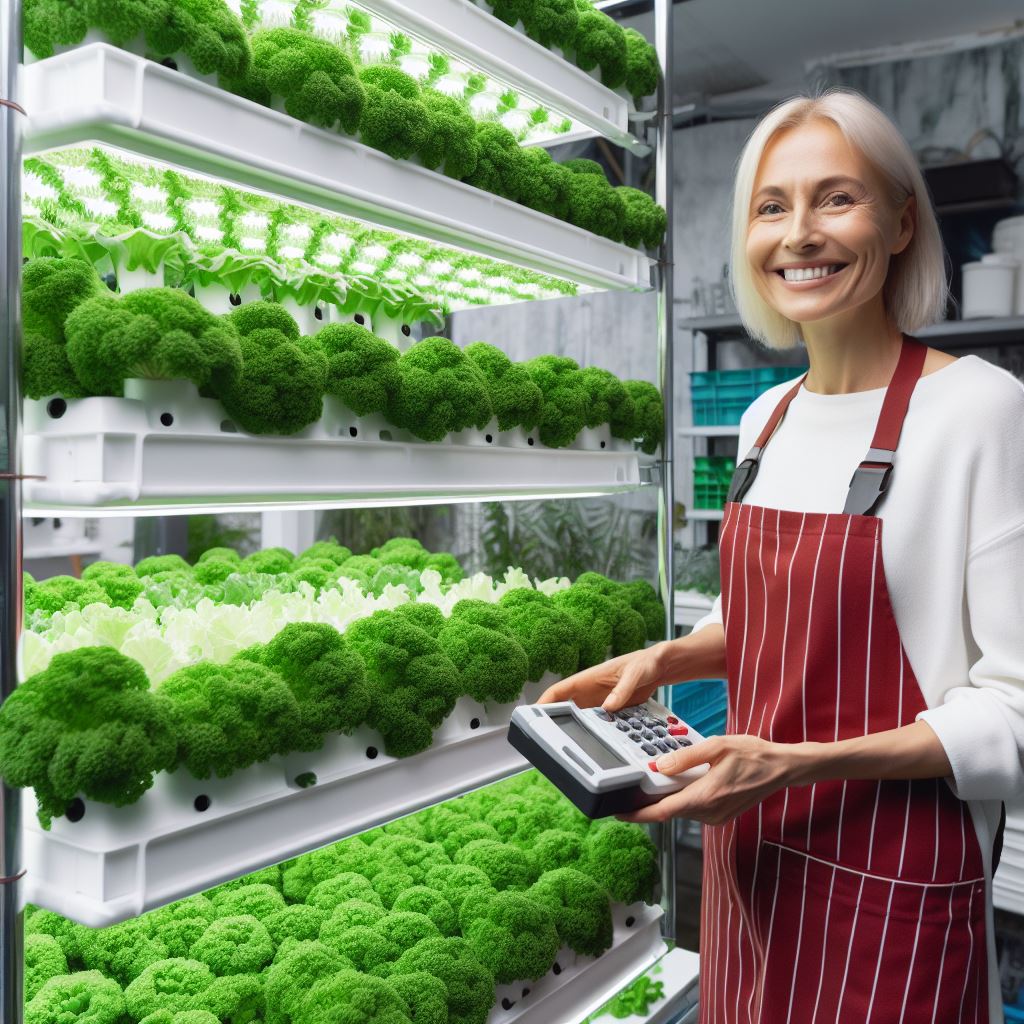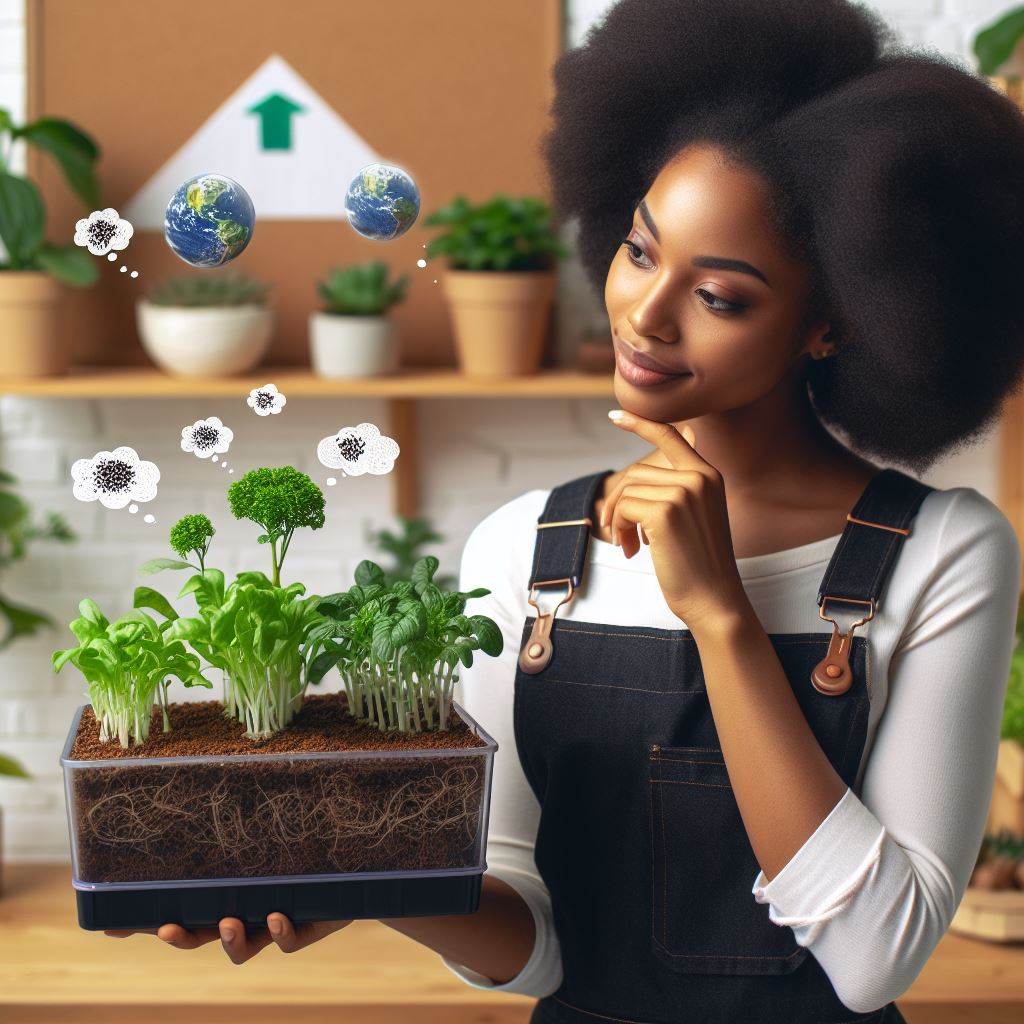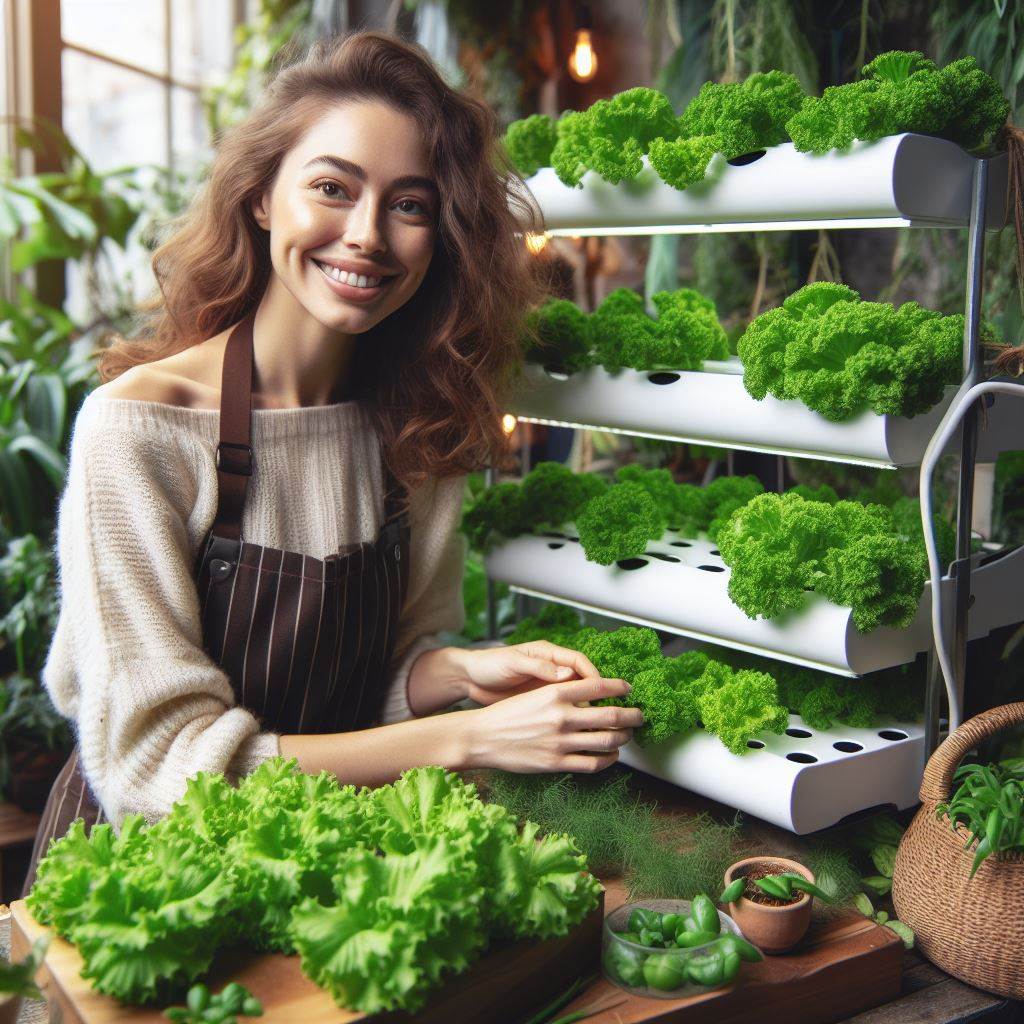Introduction
Vertical hydroponic solutions are revolutionizing the way we grow crops.
By utilizing the vertical space, these systems maximize efficiency and output.
The benefits of vertical hydroponics include increased yield, water conservation, and space optimization.
This innovative technique is gaining popularity rapidly as more and more people recognize its advantages.
Definition of vertical hydroponics
Vertical hydroponics is a revolutionary agricultural practice that maximizes space utilization by growing plants vertically.
Unlike traditional horizontal setups, vertical hydroponics allows plants to thrive in a well-organized and efficient manner.
Key Components of Vertical Hydroponic Systems
- Vertical Towers: These are the main structures in vertical hydroponics that support the plants. They are designed to provide optimum sunlight exposure and nutrient delivery to each individual plant.
- Growing Medium: Vertical hydroponics systems use various growing media like perlite, vermiculite, coconut coir, or rockwool. These media enable plant roots to grow and absorb nutrients efficiently.
- Nutrient Solution: Essential nutrients for plant growth are dissolved in water to form a nutrient solution. This solution is circulated through the vertical hydroponics system, delivering nutrients directly to the plant roots.
- Water Management: Vertical hydroponics systems are designed to efficiently recirculate and manage water usage. This reduces water waste and ensures a sustainable growing environment.
- Lighting: In indoor vertical hydroponic setups, artificial lighting is essential. LED lights provide the necessary spectrum for optimal plant growth and can be adjusted based on specific plant requirements.
How Vertical Hydroponics Differs from Traditional Horizontal Setups
- Space Efficiency: Horizontal setups require significant land space, limiting their scalability. Vertical hydroponics optimizes vertical space, allowing for greater plant density and production per square foot.
- Water Conservation: Traditional horizontal setups can have issues with water runoff and evaporation. Vertical hydroponics minimizes water wastage by recycling and reusing the nutrient solution.
- Increased Crop Yield: Vertical hydroponics systems can produce substantially higher yields compared to traditional setups due to their ability to support more plants in a compact area.
- Enhanced Nutrient Delivery: Unlike horizontal systems, vertical hydroponics delivers nutrients directly to plant roots, ensuring optimal nutrient absorption for accelerated growth and improved plant health.
- Reduced Pest and Disease Risks: Vertical hydroponics minimizes the risk of soil-borne diseases and pests that thrive in traditional setups. This leads to healthier plants and reduces the need for pesticides.
- Year-Round Cultivation: Vertical hydroponics eliminates seasonal limitations and allows for year-round cultivation, making it ideal for regions with harsh climates or limited growing seasons.
- Automation and Control: Vertical hydroponics systems often incorporate advanced technologies such as automated nutrient distribution, lighting control, and monitoring systems, enabling precise environmental control and reducing human error.
Essentially, vertical hydroponics is a game-changer in modern agriculture, breaking free from the limitations of traditional setups.
By maximizing vertical space and utilizing efficient water management, it offers a sustainable and highly productive solution for both commercial and home gardeners.
With its potential for increased crop yields, reduced space requirements, and control over growing conditions, vertical hydroponics is poised to revolutionize the way we grow plants.
So, let’s embrace the power of verticality and unlock the full potential of our agricultural future.
Read: Urban Farming: Aquaponics in the City
Advantages of Vertical Hydroponics
Space-saving benefits of vertical systems
- Vertical hydroponics allows for maximum utilization of limited space.
- By growing plants vertically, one can make the most of small urban areas or indoor spaces.
- This technique is particularly useful in crowded cities where land availability is scarce.
Increased crop yield and density
- Vertical hydroponic systems enable higher crop yields due to their vertical arrangement.
- With plants stacked on top of each other, the available growing surface area is maximized.
- This increases the number of plants that can be cultivated in a given space, resulting in higher yields.
Promotes efficient water usage
- Vertical hydroponics is highly efficient in water use compared to traditional soil-based cultivation.
- The closed-loop system recirculates water, significantly reducing water consumption.
- Additionally, vertical setups allow for precise water distribution directly to the plant roots, minimizing wastage.
Potential for year-round cultivation
- Vertical hydroponic systems provide the flexibility to grow crops all year round.
- By controlling the environmental conditions, such as temperature and lighting, plants can thrive regardless of the season.
- This allows for continuous cultivation and reduces dependence on weather conditions, ensuring a steady food supply.
Vertical hydroponics offers several advantages over traditional farming methods.
Let’s delve deeper into each of these benefits.
Space-saving benefits of vertical systems
The space-saving benefits of vertical systems are undeniable. In urban areas where land is limited, vertical hydroponics presents a viable solution.
By utilizing walls or stacking shelves, plants can grow upwards, making the most of available space.
Transform Your Agribusiness
Unlock your farm's potential with expert advice tailored to your needs. Get actionable steps that drive real results.
Get StartedThis is particularly advantageous in apartment balconies, rooftops, or even small backyards.
Increased crop yield and density
Moreover, the increased crop yield and density achieved through vertical hydroponics are remarkable.
With plants grown one above the other, a larger number of plants can be accommodated in a smaller area.
This boosts overall productivity and allows farmers to cultivate a higher quantity of crops.
Promotes efficient water usage
Water scarcity is a significant concern in many regions.
Vertical hydroponics addresses this issue by promoting efficient water usage.
The closed-loop system recirculates water, minimizing wastage.
Moreover, the precise distribution of water directly to the plant roots ensures optimal water supply and reduces evaporation.
This conservation of water resources is crucial for sustainable farming practices.
Potential for year-round cultivation
Another advantage of vertical hydroponics is the potential for year-round cultivation.
By creating a controlled environment, farmers can regulate temperature, lighting, and other growth factors.
This eliminates the reliance on seasonal variations, extending the growing season.
Year-round cultivation ensures a continuous supply of fresh produce and reduces dependence on imports.
Furthermore, vertical hydroponics offers immense opportunities for urban farming and community gardening initiatives.
With limited access to fertile land in cities, these systems empower individuals and communities to grow their own food.
It promotes self-sufficiency, sustainable living, and reconnects people with the process of food production.
Generally, vertical hydroponics provides numerous advantages.
It optimizes space utilization, increases crop yields, minimizes water consumption, and enables year-round cultivation.
Such systems are a crucial step towards sustainable and efficient food production, benefiting both urban and rural communities.
With ongoing advancements, vertical hydroponics is poised to play a vital role in the future of agriculture.
Read: Aquaponics 101: Fish & Plants in Harmony
Types of Vertical Hydroponic Systems
Vertical hydroponic systems are gaining popularity among farmers and gardeners due to their space-saving and efficient nature.
These systems allow for the cultivation of plants in a vertical rather than horizontal manner, making them ideal for urban areas or places with limited land availability.
In this section, we will explore the different types of vertical hydroponic systems, their pros and cons, and provide examples of real-world applications.
Showcase Your Farming Business
Publish your professional farming services profile on our blog for a one-time fee of $200 and reach a dedicated audience of farmers and agribusiness owners.
Publish Your ProfileTower Systems
Tower systems are one of the most common types of vertical hydroponic solutions.
They consist of multiple stacked trays or towers, each containing a separate plant or crop.
These towers are usually made of durable materials such as PVC pipes or plastic, and they can be easily customized to fit individual needs.
The plants in tower systems are typically watered from the top, allowing excess water to trickle down to the lower trays, ensuring efficient water usage.
Pros
- Tower systems maximize vertical space and can accommodate a large number of plants.
- They offer easy access to plants for maintenance, harvesting, and monitoring.
- These systems are highly scalable and can be easily expanded as the need arises.
- Tower systems are suitable for a wide range of crops, including leafy greens, herbs, and some fruiting plants.
Cons
- The initial setup cost of tower systems can be relatively high compared to other types.
- Maintaining adequate lighting and airflow throughout the tower can be challenging.
- If not properly designed and maintained, there is a risk of nutrient imbalance or waterlogging in lower trays.
Real-world Examples
- The Vertical Harvest Farm in Wyoming utilizes tower systems to grow a variety of crops, including lettuce, herbs, and microgreens, in a tight urban space.
- Bright Agrotech’s ZipGrow Tower System is widely used for commercial hydroponic farming, allowing farmers to cultivate an abundance of greens in limited areas.
Wall Gardens
Wall gardens are vertical hydroponic systems that utilize specially designed structures or panels to grow plants.
These systems are often used for decorative purposes, as they can create beautiful living walls indoors or outdoors.
Wall gardens typically incorporate a network of tubes or containers in which the plants are grown, with a nutrient solution circulating through them.
Pros
- Wall gardens add visual appeal to any space, providing a unique and natural decoration.
- They are suitable for growing a variety of plants, including flowers, herbs, and small vegetables.
- Wall gardens act as natural air purifiers, improving indoor air quality and reducing pollution.
- They can be integrated into existing buildings or structures, utilizing unused vertical spaces.
Cons
- Wall gardens may require regular maintenance, including pruning and cleaning.
- Adequate lighting may be a challenge, especially for indoor installations.
- Watering and nutrient distribution need to be carefully monitored to prevent over/underwatering or nutrient imbalances.
Real-world Examples
- The Rubens at the Palace Hotel in London has a vertical garden installation that covers 350 square meters and showcases over 10,000 plants.
- The Green Wall at the Musee du Quai Branly in Paris is an impressive example of a large-scale living wall, featuring more than 15,000 plants.
Stacking Systems
Stacking systems, also known as multilayer systems, are vertical hydroponic setups that allow plants to be grown in multiple layers or tiers.
These systems often utilize shelves or racks with built-in lighting and irrigation systems, making them highly efficient for commercial indoor gardening.
Each layer can be independently controlled, creating custom environmental conditions for different crops.
Pros
- Stacking systems maximize space utilization, allowing for greater plant density per square foot.
- They offer excellent control over lighting, temperature, and humidity, resulting in optimal plant growth.
- Stacking systems are suitable for various crops, including lettuce, strawberries, and small herbs.
- These systems are often modular and can be easily tailored to fit specific needs or available space.
Cons
- Stacking systems may require a more complex setup and maintenance compared to other options.
- Proper air circulation and adequate lighting distribution need to be ensured between the layers.
- The initial cost of setting up a stacking system can be higher, especially for large-scale operations.
Real-world Examples
- AeroFarms, based in New Jersey, utilizes a highly efficient multilayer stacking system for commercial leafy green production.
- Plenty, an indoor vertical farming company, employs a stacking system to grow a variety of crops, ensuring year-round availability and reducing transportation costs.
As the demand for sustainable and efficient farming solutions continues to rise, vertical hydroponic systems offer a versatile and space-saving approach.
Whether it’s tower systems, wall gardens, or stacking systems, each type has its advantages and considerations.
Real-world applications showcase the potential of these systems in maximizing production while minimizing resource usage.
By embracing vertical hydroponic solutions, we can create a greener, more productive future for agriculture.
Read: DIY Hydroponics: Start Your Soil-less Garden!

Essential components for success
Importance of lighting in a vertical hydroponic setup
- The importance of lighting in a vertical hydroponic setup cannot be overstated.
- Proper lighting provides the necessary energy for photosynthesis and helps plants grow.
- LED lights are commonly used in vertical hydroponic systems due to their energy efficiency and customizable spectrum.
- Light intensity, duration, and spectral composition must be carefully controlled to optimize plant growth.
- Natural light can also be utilized by placing hydroponic setups near windows or using skylights.
The role of nutrient delivery systems in vertical hydroponics
- The role of nutrient delivery systems in vertical hydroponics is crucial for plant health and growth.
- A well-designed system ensures that plants receive all the essential nutrients in the right proportions.
- Common nutrient delivery systems include drip irrigation, nutrient film technique, and aeroponics.
- Automated nutrient delivery systems can precisely regulate nutrient levels for optimal plant nutrition.
The need for proper ventilation and air circulation
- Proper ventilation and air circulation are essential in a vertical hydroponic system.
- Good airflow prevents the buildup of excess heat and humidity, reducing the risk of mold and disease.
- A well-ventilated system also aids in the exchange of gases, allowing plants to perform efficient respiration.
- Strategic placement of fans and openings helps maintain a consistent and healthy growing environment.
Significance of selecting the right growing medium
- The right growing medium is critical for the success of a vertical hydroponic setup.
- Growing mediums, such as perlite, coconut coir, or rockwool, support plant roots and provide stability.
- The chosen medium should retain water, allow for proper drainage, and provide adequate aeration.
- It is important to select a growing medium that is free from pests and diseases.
- Regular monitoring and maintenance of the growing medium is necessary to ensure optimal plant growth.
In general, for a successful vertical hydroponic system, it is vital to address the essential components mentioned above.
Adequate lighting provides the energy needed for photosynthesis, while nutrient delivery systems ensure plants receive necessary nutrients.
Proper ventilation and air circulation prevent the buildup of heat and humidity.
The right growing medium supports plant roots and provides stability.
By carefully considering and implementing these components, vertical hydroponic enthusiasts can achieve flourishing and fruitful crops.
Read: Eco-Friendly Pots: Sustainable Gardening
Tips for Setting Up a Vertical Hydroponic System
Choosing the Right Location
- Consider the availability of natural light when selecting the location for your vertical hydroponic system.
- Ensure that the area has sufficient space to accommodate the height and width of the setup.
- Keep in mind that the location should have easy access to water, electricity, and necessary tools.
Assembling the Vertical Hydroponic Setup
- Begin by assembling the supporting structure, such as vertical towers or racks, according to the design.
- Install the necessary irrigation system, ensuring proper water flow and nutrient distribution.
- Set up the reservoir, which will contain the nutrient solution for the plants.
- Place the seedlings or seeds into the net pots or grow media, making sure they are secure.
- Connect the irrigation system to the reservoir and adjust the flow rate for optimal growth.
- Finally, ensure that the plants have sufficient spacing and room to grow vertically.
Monitoring and Adjusting Nutrient Levels
- Regularly monitor the pH and nutrient levels in the reservoir to ensure they are within the appropriate range for the plants.
- Maintain a pH level between 5.5 and 6.5 for most hydroponic crops.
- Adjust the nutrient solution as necessary to provide the right balance of essential elements for optimal plant growth.
- Keep an eye on plant health and growth, as any signs of nutrient deficiencies or imbalances should be addressed promptly.
Starting with Easy-to-Grow Crops
- Beginners should consider starting with easy-to-grow crops such as lettuce, herbs, or leafy greens.
- These crops tend to have shorter growing cycles and are more forgiving in terms of nutrient requirements.
- As you gain experience and confidence, you can gradually introduce more challenging plants to your vertical hydroponic system.
In essence, setting up a vertical hydroponic system requires careful consideration of the location, proper assembly of the setup, monitoring and adjusting nutrient levels regularly, and starting with beginner-friendly crops.
By following these tips, you can create a thriving vertical hydroponic garden and enjoy the benefits of fresh, homegrown produce throughout the year.
Success stories and examples
Vertical hydroponics has gained popularity in recent years for its ability to maximize space and increase crop yields.
It has revolutionized farming practices by providing innovative solutions to common challenges faced by farmers.
Here are some success stories and examples demonstrating the power of vertical hydroponics:
Success Stories
- Farmer John, who operates a small-scale vertical hydroponic farm, saw a 70% increase in crop yields compared to traditional farming methods.
- Organic Greens, an organization specializing in vertical hydroponics, successfully provided fresh produce to local restaurants year-round, eliminating the need for long-distance transportation.
- Urban Farm Co., a vertical hydroponic farm located in a city center, has created job opportunities for unemployed residents while supplying the community with fresh, sustainable food.
- Farmer Sarah adopted vertical hydroponics to overcome the limited land availability on her farm. She now grows a wide variety of crops, expanding her market reach.
- The Pioneering Agriculture Initiative supported several small farmers in developing countries to implement vertical hydroponics, leading to increased food security and economic stability.
Real-World Examples
- In Singapore, Sky Greens’ vertical farm is a prime example of how this technology helps combat food scarcity in urban environments.
- Vertical Harvest in Wyoming, USA, utilizes hydroponics to grow fresh produce year-round despite the region’s harsh climate.
- Japan’s Mirai Co. employs vertical hydroponics in their urban farms to provide Tokyo with locally sourced vegetables.
- The Green Sense Farms in Indiana uses vertical hydroponics systems to provide consistent, year-round supply to nearby grocery stores.
- The Center for Alternative Plant and Animal Products in Florida incorporates vertical hydroponics to research and develop sustainable farming techniques.
Addressing Food Scarcity
Vertical hydroponics offers great potential in addressing global food scarcity issues.
By using this method, farmers can increase their production rates significantly, even in limited spaces.
Vertical farms can be established in urban areas, reducing transportation costs and carbon emissions associated with traditional agriculture.
Furthermore, vertical hydroponics allows for precise control over the growing environment, ensuring optimal conditions for plants.
This results in higher yields and reduces water usage compared to traditional farming practices.
By providing a consistent and reliable supply of fresh produce, vertical hydroponics helps alleviate issues related to food shortages and price fluctuations.
Additionally, vertical hydroponics can be implemented in food-insecure regions, enabling communities to become self-sufficient in food production.
This technology allows farmers to grow crops indoors, unaffected by external factors like weather conditions, pests, and diseases.
It gives them the ability to produce a variety of vegetables and herbs, enriching local diets and improving nutritional levels.
In a nutshell, vertical hydroponics has proven to be a game-changer in modern farming.
The success stories and real-world examples demonstrate its potential to revolutionize food production by increasing yields, providing year-round availability, and addressing global food scarcity.
As we continue to face agricultural challenges, vertical hydroponics offers an innovative and sustainable solution for a brighter and more food-secure future.
Conclusion
Vertical hydroponic solutions offer numerous advantages and have immense potential.
They enable efficient use of space, save water, and produce higher yields.
Showcase Your Farming Business
Publish your professional farming services profile on our blog for a one-time fee of $200 and reach a dedicated audience of farmers and agribusiness owners.
Publish Your ProfileThis innovative farming technique holds promise for sustainable food production in urban areas.
I encourage readers to explore and embrace vertical hydroponics for its environmental and economic benefits.
To learn more about this technique, I recommend checking out online resources such as research papers, articles, and instructional videos.




